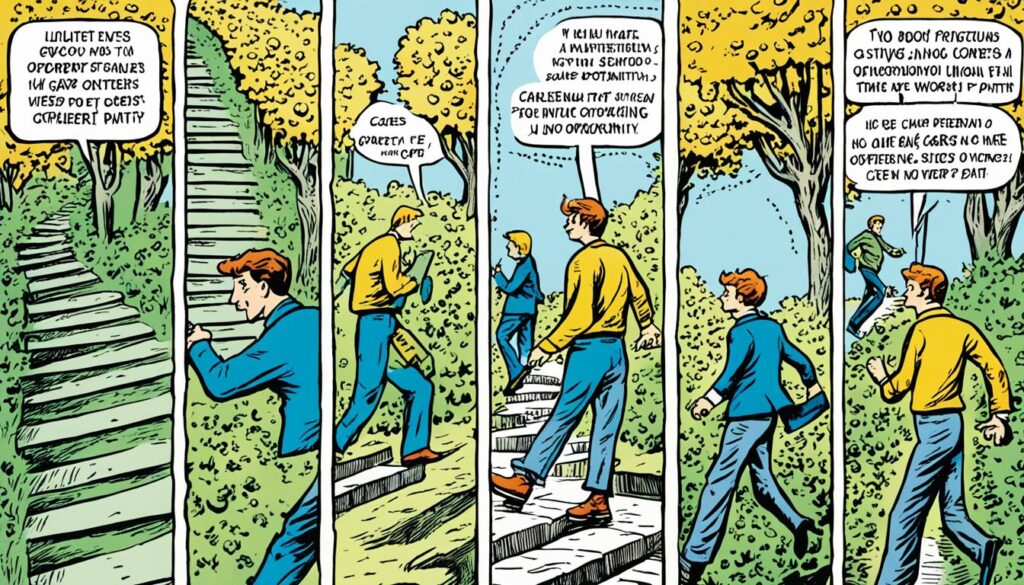Your resume is the first impression employers get, so it must shine. It should display your qualifications, skills, and achievements. Knowing recruiters spend only about 5-6 seconds reviewing each resume is key.
With over 100 resumes for each job, yours needs to be brief, powerful, and grab attention quickly. Using commercial advertising techniques can make you stand out. Think of including a catchy 7-10 word description of your main strength.
Avoid adding fluff that detracts from your resume’s essential message. Although “power words” were once popular, they may not be as effective today.
Getting your resume professionally written can greatly aid your job hunt. Some paid hefty sums for resumes that didn’t get any replies. Others had the same issue, even after spending a lot.
Seek out an experienced writer for help. Our expert has 25 years under their belt and has crafted 5,000 resumes. Expect to spend $800-$2400 for their services. You should also spend 2-3 hours talking to them to make sure your story is told right.
Quick review is vital. Check your resume within 48 hours of getting it to request any changes. This ensures it meets your goals and desires. By doing so and investing in a pro resume, you boost your job chances significantly.
Key Takeaways:
- Recruiters spend only 5-6 seconds on each resume, so make it impactful.
- Commercial advertising principles can help you present yourself effectively in a few words.
- Using “power words” may have lost its effectiveness due to widespread use.
- Investing in a professionally written resume can make a significant difference.
- Expect to pay between $800-$2400 for a professionally written resume.
Choose the Right Template for Your Skills and Goals
Choosing the right resume template is key. With many options online, pick one that matches your skills and goals.
Resumes are the first thing employers see. They decide if you get an interview. A good template should enhance your resume, not distract from it.
Don’t just use any template from word processors like Microsoft Word. Often, they don’t show your unique skills well.
Go for professionally designed templates instead. They’re made by career experts for a good reason. They help your resume get past screening software. Plus, they avoid things that software can’t read well.
Don’t add images or symbols that Applicant Tracking Systems can’t understand. It’s important to keep the focus on your content.
There are templates for specific industries and jobs, too. They highlight what’s most valued in your field.
If writing your resume is tough, think about hiring a professional writer. They make sure your resume shows your best side.
Having the right resume can make you stand out. Choosing a good format and design is crucial. With the right approach, your chances to get noticed improve.
| Statistic | Percentage |
|---|---|
| Resumes with typos or grammatical issues | Close to 60% |
| Resumes discarded for unprofessional email addresses | 76% |
| Resumes with photos | 88% rejection rate |
| Resumes eliminated by applicant tracking software | 75% due to lack of keywords |
| Average time spent scanning a resume | 6 seconds |
| Chance of getting a job with the right resume format | 30% higher |
| Response rate from recruiters with optimized resume template | 42% higher |
These statistics show how vital your resume format is. Choose a design that highlights your skills. It can really shape your success.
Highlight Your Skills and Expertise
Employers today are on the lookout for candidates with a strong skillset and expertise. It’s crucial to showcase these abilities on your resume. This helps make a great first impression on hiring managers.
Hiring managers often spend just a short time reviewing a resume. This means it’s important for your skills and expertise to grab their attention quickly.
It’s vital to include both hard and soft skills. Hard skills come from education and training. They show your abilities in things like computers, leadership, communication, organizing, and solving problems.
Soft skills are equally important to hiring managers. They display your skills in adapting, working well with others, effective communication, decision-making, empathy, and time management. Some soft skills are adaptability, creativity, customer service, leadership, and work ethic.
Employers look for people who can adjust to new situations, think out of the box, deliver great customer service, make decisions, motivate teams, handle multiple tasks, stay positive when solving problems, handle disagreements, and manage their time well.
For hard skills on your resume, list specific skills and certifications relevant to the job. This makes it easy for recruiters to see your abilities and qualifications.
Here are the top 10 skills employers look for on LinkedIn: Customer Service, Sales, Accounting, Business Development, Marketing, Leadership, Communication, Digital Marketing, Sales Management, and Problem Solving.
According to ZipRecruiter, 93% of employers think soft skills are critical during hiring. The top eight soft skills are: Communication, Customer service, Scheduling, Time management, Project management, Analytical thinking, Independence, and Flexibility.
When showcasing your skills, be strategic. Career coaches suggest listing no more than six skills on your resume. Choose the ones that best highlight your abilities.
LinkedIn experts recommend adding a profile photo and a banner image on LinkedIn for better visibility. Also, list your main skills in the LinkedIn skills section. This makes it easier for recruiters to find you.
Craft a Compelling Objective Statement
Creating a standout resume in a tough job market needs a strong objective statement. It’s your shot to share your goals, show your confidence, and point out your strengths. Make your objective suit the job you want, showing your skills and key words that match.
Your objective statement should briefly talk about your skills, passions, and values. Use it to connect your past work to the job you want now. This is also a chance to show skills you can carry over, especially if you’re moving to a new field.
Use clear phrases to kick off the application for different jobs. Adding numbers and achievements in your objective makes you stand out. Hiring teams, who only look at resumes for about 6.2 seconds, will notice you more.
Make your objective fit the job, career, and industry you’re targeting. Showing how you can help the company and match the job ad can make a big difference. You’ll likely leave a good impression.
No matter if you’re just out of school, changing careers, or have years of experience, spend time on your objective statement. This is your chance to share your goals, show your confidence, and stand out in your job search.

| Key Statistics: |
|---|
| A career objective is typically two to three sentences long and is positioned at the top of a resume. |
| A well-written career objective enhances the chances of a resume standing out in a competitive job market. |
| Career objectives for job seekers changing fields should aim to link past experiences to the desired role and highlight transferable skills. |
| About 27 examples of great resume objective statements are provided in the text. |
| Recruiters and hiring managers spend an average scan time of 6.2 seconds per resume review, as per a study by The Ladders. |
Showcase Your Online Presence
Having a strong online presence is key in today’s job market. Employers often look at social media and other online platforms to check on candidates. It’s important to show off your skills and knowledge online. Therefore, maintaining a professional and polished image across your online profiles is crucial. Additionally, many individuals are capitalizing on the digital landscape by exploring the best places to earn online, whether through freelancing platforms or remote job sites. Demonstrating your expertise and building a positive digital footprint can open more opportunities in today’s competitive market.
Many job seekers use work samples, portfolios, websites, and social media to build their brand. But, a lot of them don’t have a strong digital presence.
Putting relevant links on your resume is a smart move. These can be links to your social media, online portfolio, or personal website. Here, you can share your interests, what you’re passionate about, and your past projects.
Sharing content related to the job you want or your original work can make you stand out.
Be careful with what you post on social media. Make sure it matches your professional image. Cleaning up your online image is crucial, as employers often check this.
Posting about your industry online shows you’re eager to learn and grow professionally. Attending workshops or conferences also helps showcase your dedication to your career.
Creating a professional website can take your online presence up a notch. Platforms like GoDaddy.com and Wix.com are affordable. They help you set up a site to share your achievements through photos and videos.
Writing articles about your industry can boost your visibility and credibility. Make sure your articles are detailed, offering deep insights.
LinkedIn has been a key platform for professional networking since 2003. It offers great networking chances and is essential for job seekers.
Keep in mind, 94% of recruiters use social media to find candidates. 67% check social media before deciding. It’s important to keep your resume and social media consistent.
Regular updates and showing real work online is fundamental for a strong digital presence. Sadly, not many job seekers use this to their advantage.
| Statistic | Insight |
|---|---|
| Percentage of employers researching candidates on social media | Significantly increased in recent years |
| Percentage of job seekers with work samples, portfolios, websites, digital hubs, and social media accounts | To enhance their personal brand |
| Percentage of job seekers who do not have a strong digital presence | Notable percentage |
| Percentage of job seekers with LinkedIn and Twitter accounts | Including LinkedIn and Twitter accounts |
| Percentage of job seekers who update their online presence | Importance of regularly updating online presence |
| Percentage of job seekers who review and clean up their social media accounts | Need to review and clean up social media accounts |
| Percentage of job seekers who showcase tangible work to potential employers | Highlight the significance of showcasing tangible work |
| Percentage of job seekers who share industry-related content online | Importance of sharing industry-related content |
| Percentage of job seekers attending workshops or conferences and sharing insights online | Attending workshops or conferences and sharing insights online |
| Number of print and digital bylines published by Deanna Hartley | Extensive experience in the job search and career development field |
Standing out in today’s job market means showing off your online presence. Use social media, portfolios, and websites to highlight your skills and work. Keep your online presence fresh, clean up your social media, and post about your industry. A professional website and writing articles can also boost your visibility. Keep your resume and social media consistent for credibility. With a strong digital presence, you can grab recruiters’ attention and improve your job search results. Additionally, engaging in relevant discussions and networking with industry professionals on platforms like LinkedIn can further expand your reach. Be mindful of online opportunities that align with your skills, as there are numerous ways to **make money online fast**, including freelance projects or gig-based work. In today’s digital age, leveraging every aspect of your online presence is key to opening new doors and enhancing your career trajectory.
Use Relevant Keywords
Creating a resume that stands out requires using relevant keywords. It’s vital to know how applicant tracking systems (ATS) work. They filter out about 75% of applications. So, the right keywords greatly boost your chance to catch the eye of recruiters and employers.
Begin with the job listing to find the right resume keywords. Match these to the job and industry terms. For instance, for a marketing role, add “digital essay definition,” “SEO,” and “social media management.”
Avoid using hidden text for keywords, as the ATS can spot that. Instead, weave your keywords into your resume. Show your skills and experiences clearly. Like, if project management is key, highlight your project management work.
Using keywords wisely is crucial. Don’t cram your skills list or repeat too much. Choose 8-16 important keywords from the job ad. Then, work them into your resume naturally.
If you’re not sure about your keyword choices, use a free ATS scanner. It can check your resume and suggest improvements. This helps make sure your resume will pass the ATS test.
Relevant keywords help get your resume seen. They show you know your stuff, making recruiters and employers take notice. Spend time crafting a resume that shows off your skills and experiences well. Use examples that match the job keywords.
Need help making your resume better? Consider getting help from career or recruitment centers. They offer great advice to improve your resume’s effectiveness.
![]()
Use Action Verbs
When writing your resume, make sure to use action verbs. They highlight your experience and technical skills. Often, resumes repeat common verbs like “led,” “responsible for,” and “managed.” To stand out, use a wide range of verbs and phrases.
Action verbs come in different categories based on job duties. These include:
- Creating or writing
- Conducting research
- Managing projects or groups
- Dealing with numbers and figures
- Bringing ideas to life
- Helping with a project
- Explaining technical expertise
- Teaching
There are many specific verbs for each category. They can help show off your achievements better. For example, use “developed,” “implemented,” or “oversaw” instead of just “managed a project.”
To make your achievements stand out, use numbers. For example:
| Accomplishment | Quantifiable Impact |
|---|---|
| Redesigned the main homepage | 18% increase in site visits |
| Streamlined incident response reports | Reduced average time to 12 minutes from 18 minutes |
| Generated three new TikTok campaigns | 32% more engagement on the platform |
Using varied and engaging verbs can catch a recruiter’s eye. Your resume will be more effective. Here are 150 resume action words to improve your resume:
Created, analyzed, administered, adjusted, managed, supervised, organized, collaborated, researched, developed, implemented, resolved, optimized, executed, facilitated, coordinated, evaluated, resolved, communicated, presented, trained, mentored, coached, inspired, solved, improved, negotiated, assessed, forecasted, examined, recommended, streamlined, enhanced, monitored, tracked, strategized, directed, guided, generated, launched, achieved, exceeded, influenced, led, motivated, initiated, pioneered, innovated, secured, established, designed, integrated, maintained, upgraded, solved, resolved, approved, tracked, supported, conducted, validated, specialized, generated, marketed, orchestrated, drafted, modified, programmed, debugged, communicated, formulated, documented, audited, analyzed, completed, created, edited, proposed, implemented, streamlined, estimated, forecasted, collaborated, delegated, verified, controlled, presented, assessed, executed, supervised, reviewed, initiated, designed, developed, consolidated, maintained, resolved, optimized, improved, researched, identified, managed, mentored, trained, coached, facilitated, planned, strategized, advised, negotiated, influenced, evaluated, executed, delegated, directed, coordinated, organized, monitored, tracked, led, motivated, inspired, exceeded, achieved
Action words are a key way to describe your professional journey. They showcase your skills, achievements, and areas of expertise. When choosing words for your resume, look for synonyms in a thesaurus. This avoids repetition and can also include adverbs to highlight your accomplishments.

Quantify Your Accomplishments
On your resume, showing your professional wins is key. It’s important to quantify your achievements. This shows the real outcome and impact of your work. Employers want to see not just what you did, but the results of your efforts.
To do this, start with specific numbers or percentages. For example:
- Generated $2 million revenue in FY 2023 by strategically acquiring and expanding key accounts, leading to a $500,000 increase in overall company profit.
- Enhanced customer satisfaction by 25% within a six-month period by implementing a new customer feedback system, resulting in a subsequent 15% increase in customer retention rates.
- Achieved a sales-to-hours ratio of 3:1, optimizing productivity and closing deals worth $500,000 in Q3 2023.
- Maintained an average customer satisfaction rating of 4.7/5, contributing to a 20% increase in repeat business.
- Halted a 25% sales decline and increased year-over-year sales by 45% through updating and reorganizing sales collateral.
These numbers don’t just show your skills. They prove the impact you’ve made. It tells hiring managers what you could bring to their team. It also helps you stand out from other applicants.
Make sure each accomplishment is tailored to the job you’re applying for. Focus on what’s most relevant and impressive. You can use a formula like this: “[Action verb] [X] to [Y], resulting in [Z].” This approach shows what you did, the change you made, and its impact.
It’s also important to be clear and to the point. Use bullet points to list your wins, making them easy for managers to scan.
In summary, showing your value with numbers and results is crucial. Include these specifics in your resume. This will help highlight your success and make you a strong candidate.
| Accomplishment | Impact |
|---|---|
| Generated $2 million revenue in FY 2023 | $500,000 increase in company profit |
| Enhanced customer satisfaction by 25% | 15% increase in customer retention rates |
| Achieved sales-to-hours ratio of 3:1 | $500,000 worth of closed deals in Q3 2023 |
| Maintained average customer satisfaction rating of 4.7/5 | 20% increase in repeat business |
| Halted 25% sales decline | 45% year-over-year sales increase |
Highlight Your Hobbies and Interests
When making your resume, it’s key to not only talk about your job skills and history but to also share your personal side. Adding hobbies and interests helps you shine among other job seekers. It shows you have a lot more to offer.
Studies have found that bosses like to see candidates with hobbies. These activities tell them about your fit in the company culture, personal growth, and well-being. They also give extra value to your resume, especially if you’re new to the job scene or changing career paths.
Choose hobbies that match the job and show off your personality and abilities. Pick ones that agree with the company’s culture. Make sure they are suitable and non-controversial.
Types of Hobbies and Interests to Consider:
| Category | Description | Skills and Qualities Showcased |
|---|---|---|
| Community Involvement | Volunteering, charity work, community service | Management skills, planning, speaking, kindness, care for others |
| Creative Pursuits | Painting, writing, photography, music | Creativity, project management, perseverance, love for originality, solving problems in new ways |
| Continuing Education | Online courses, workshops, professional certifications | Eagerness for professional growth, quick to adapt, self-driven, committed to learning more |
| Professional Development | Attending industry conferences, joining professional organizations | Keen on industry trends, best practices, always learning |
Give clear examples of your hobbies and interests. For instance, say you love reading science fiction novels because they improve your thinking and solving skills, not just “reading.”

By adding hobbies and interests to your resume, you present yourself as a well-rounded candidate. It’s a way to show skills that might not be obvious elsewhere. So, openly share what you love doing with future employers!
Address Potential Concerns
Creating a great resume involves addressing potential issues head-on. One issue is job history gaps which hiring managers might notice. To lessen their worries, show your adaptable skills and explain any job history gaps.

There are many reasons for employment gaps, including changing careers, studying more, caring for others, or traveling. These gaps might worry recruiters, but you can show them your adaptability and problem-solving skills.
Talk about what you’ve done in those gap times that enhanced your skills. This can be volunteer work, freelance gigs, research, or courses. Highlighting these skills shows you’ve grown professionally despite breaks in employment.
Be honest and share details on the skills and experiences that make you a strong applicant. Don’t forget to mention any certifications or training you’ve completed during employment gaps to show your dedication to growing professionally.
Addressing Concerns about Omitting Residential Address
Not adding a full address to your resume might worry you. Though about 60% of hiring managers like to see a full address, your concerns over privacy or discrimination for leaving it off are understandable. Close to 20% of applicants choose to leave their address off for these reasons.
If you choose to skip the full address, consider at least noting your state. This helps employers know your general area and helps your resume get through certain filters. If the job is on-site, including your city shows you can easily commute and helps companies with time zone considerations.
Today, listing just your city and state is often enough. Adding more details might raise safety issues and isn’t usually needed.
By facing potential concerns like employment gaps and address omission upfront, you can clear hiring managers’ doubts. This approach highlights your flexibility, eagerness for growth, and makes you a stronger candidate.
Conclusion
By following these resume tips, you can enhance your resume. This increases your chances of landing a job. Select a template that best displays your skills and goals. Highlight your expertise and show off your achievements to stand out.
Showcase your online presence, like professional websites or social media profiles. Add relevant keywords to make your resume visible in job searches. Be open and confident about any gaps in employment.
Personalization and showing your value are key to get the recruiter’s attention. Make a pitch that shows your skills and how you can meet the company’s needs. Use examples of your work to show what you bring to the table.
Recruiters prefer cover letters that speak directly to them rather than generic ones. End your cover letter on a high note by focusing on your strengths. Add a confident call to action, say thank you, and sign off professionally. You might also include your contact info and a link to your portfolio.
By using these strategies, you can improve your resume and cover letter. This will help you in your job search and get you the job you want. Good luck with your job search!









